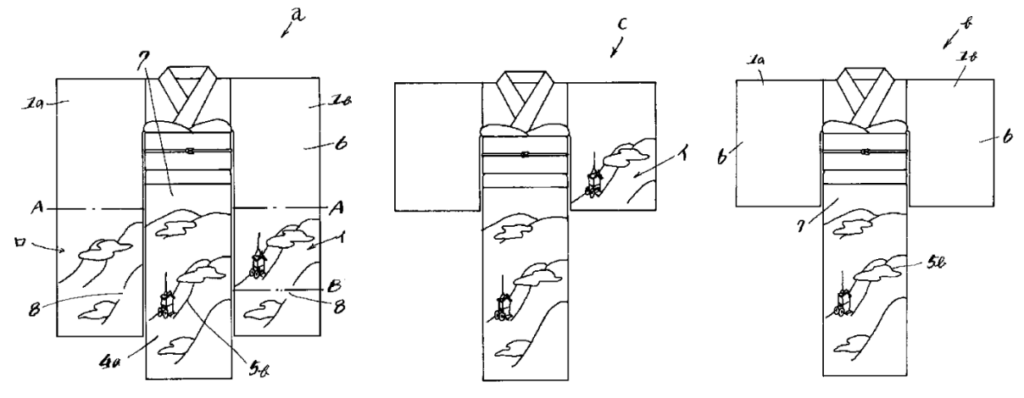
- Overview of the Patent Drawing
- Patent Insight 1: Versatile Kimono Design for Multiple Occasions
- Patent Insight 2: Practical Solution for Extending the Usability of Furisode
- Patent Insight 3: Seamless Pattern Adjustment Techniques
- Thoughts on the Patent Drawing
- Keywords
- Application of the Technology: Transformable Theater Costume for On-Stage Character Shifts
Overview of the Patent Drawing
The illustrations show a kimono designed to be convertible, allowing a traditional furisode (long-sleeved kimono) to be altered into an irotomesode (short-sleeved kimono with one family crest) or houmongi (semi-formal kimono). The diagrams (a, c, f) demonstrate different configurations and adjustments to the kimono’s sleeves (1a, 6) and body (1) to achieve this transformation. Specific areas, such as patterns (4a, 5a) and guide lines (A, B), indicate where modifications are made to ensure a seamless appearance when changing styles.
Patent Insight 1: Versatile Kimono Design for Multiple Occasions
The ability to convert a furisode into an irotomesode or houmongi significantly enhances the kimono’s versatility, allowing the wearer to use a single garment for various formal occasions. This adaptability reduces the need for owning multiple kimonos for different events, making it a practical and cost-effective option for modern kimono wearers who seek convenience without compromising on traditional elegance.
Patent Insight 2: Practical Solution for Extending the Usability of Furisode
Furisode are traditionally worn by young, unmarried women, but this design allows the garment to be repurposed for use after marriage, when wearing irotomesode or houmongi is more appropriate. The ability to modify the sleeve length and style provides a practical way to extend the lifespan and usability of the kimono, maintaining its value and cultural significance.
Patent Insight 3: Seamless Pattern Adjustment Techniques
The design incorporates methods for maintaining the continuity of the pattern even after transformation. The guide lines (A, B) help ensure that the design remains aesthetically pleasing, with patterns aligning seamlessly across the kimono’s panels. This approach respects the traditional craftsmanship while providing modern functionality, making it suitable for those who wish to preserve the cultural essence of kimono.
Thoughts on the Patent Drawing
When I first explored the patent drawing for the “Convertible Kimono for Transforming Furisode into Irotomesode or Houmongi (Semi‑Formal Kimono),” I found myself softly smiling—this is practical elegance personified. The ability to adapt a single garment from a flamboyant, long-sleeved furisode (typically worn by unmarried women) to more subdued, semi-formal styles speaks to a blend of tradition and modern wardrobe flexibility.
What really caught my attention was how thoughtfully this transformation is engineered—panel placements, detachable sections, or clever folding techniques all seem designed to maintain the kimono’s silhouette and grace throughout each style change. I could almost feel the fabric’s movement as one transitions from festive to formal settings, seamlessly redefining cultural expression without sacrificing the garment’s beauty.
This convertible kimono feels like a kind friend to modern wearers—a way to honor heritage while adapting to contemporary lifestyles. It would allow someone to attend a coming-of-age ceremony in traditional finery and then effortlessly shift to a more reserved look for subsequent gatherings—all with the same piece. As someone who values both respects for tradition and practical style, this patent resonates deeply with me.
Keywords
convertible kimono, furisode, irotomesode, houmongi, semi-formal kimono, kimono transformation, traditional Japanese clothing, versatile kimono, pattern continuity
Application of the Technology: Transformable Theater Costume for On-Stage Character Shifts
Purpose
To adapt the convertible kimono mechanism into a dramatic quick-change stage costume, enabling seamless mid-performance transformations to dazzle audiences.
System Components
- Base Outfit: Lightweight undergarment worn by the performer (e.g., superhero suit)
- Outer Layers: Multiple textile overlays featuring different patterns/colors
:Magnet-attached skirt layer
:Cape that zips open like a wing
:Sash with reversible inner pattern - Transformation Mechanisms:
:Spring-loaded panels for snap-open effects
:Tear-away velcro flaps for quick reveal
Operational Flow
- Performer enters stage in “normal” costume and acts as a civilian or early-stage character
- At the climax, cues a transformation sequence (“Transform now!”)
- Skirt pops off, sash flips to reveal new color, cape unfurls dramatically
- Audience erupts with surprise and applause
- Scene transitions smoothly into a new act with the transformed character
Kimono engineering meets theater magic—for the fastest wardrobe change in history.



